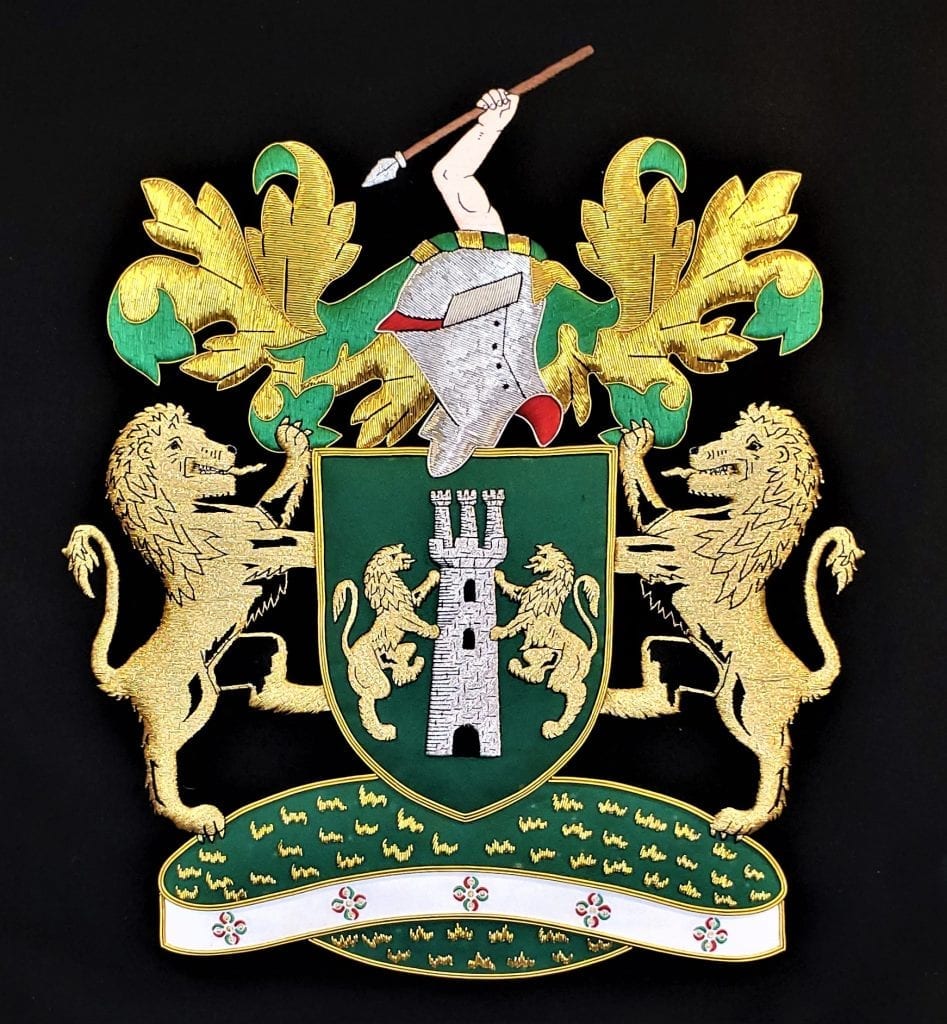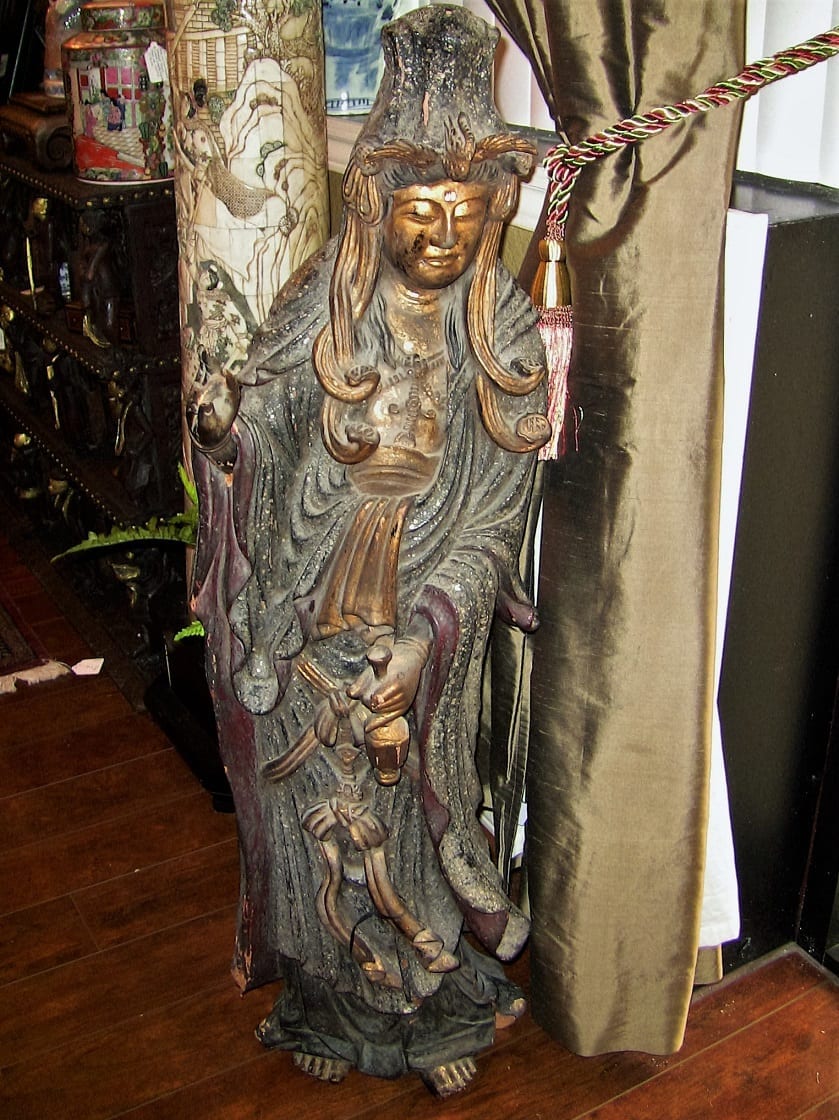19C Asian Wooden Carved, Painted & Gilded Guanyin Statue
PRESENTING A STUNNING 19C Asian Wooden Carved, Painted & Gilded Guanyin Statue.
This Wooden Statue is hand carved, hand-painted and hand-gilded.
It depicts the Buddhist Goddess of ‘GUANYIN’.
Guanyin is an East Asian bodhisattva associated with compassion as venerated by Mahayana Buddhists. She is commonly known as the “Goddess of Mercy” in English. The name Guanyin is short for Guanshiyin, meaning “[The One Who] Perceives the Sounds of the World”. She is also referred to as Guanyin Bodhisattva (traditional Chinese: 觀世音菩薩; simplified Chinese: 观世音菩; pinyin: Guān shì Yīn Pú Sà). Some Buddhists believe that when one of their adherents departs from this world, they are placed by Guanyin in the heart of a lotus, and then sent to the western pure land of Sukhāvatī. Guanyin is often referred to as the “most widely beloved Buddhist Divinity” with miraculous powers to assist all those who pray to her as listed in the Lotus Sutra and Karandavyuha Sutra. Several of the biggest temples in East Asia are dedicated to Guanyin including Shitennoji, Sensoji, Kiyomizu-dera and Sanjusangendo as well as Shaolin. Guanyin is beloved by all Buddhist traditions in a non-denominational way and can be found in some of the most important centers of Indian Buddhism including the Mahabodhi Temple, Ajanta Caves and Nalanda Museum as well as most Tibetan temples where He is referred to as Chenrezig. Furthermore, Guanyin can also be found in some influential Theravada temples such as Gangaramaya and Kelaniya of Sri Lanka as well as the Asian art sections of most museums in the world as a widely depicted subject of Asian art and sculpture.
It is generally accepted among East Asian adherents that Guanyin originated as the Bodhisattva Avalokiteśvara. Commonly known in English as the Mercy Goddess or Goddess of Mercy but often depicted as both male and female to show this figure’s limitless transcendence beyond gender Guanyin is also revered by Taoists as an immortal. In Chinese folk religion, there are mythical accounts about Guanyin’s origins that are not associated with the Avalokiteśvara described in Buddhist sutras.
Guanyin is an extremely popular goddess in Chinese folk religion and is worshiped in many Chinese communities throughout East and South East Asia. In Taoism, records claim Guanyin was a Chinese woman who became an immortal, Cihang Zhenren in Shang Dynasty or Xingyin (姓音).
Guanyin is revered in the general Chinese population due to her unconditional love and compassion. She is generally regarded by many as the protector of women and children. By this association, she is also seen as a fertility goddess capable of granting children to couples. An old Chinese superstition involves a woman who, wishing to have a child, offers a shoe to Guanyin. In Chinese culture, a borrowed shoe sometimes is used when a child is expected. After the child is born, the shoe is returned to its owner along with a new pair as a thank you gift.
Guanyin is also seen as the champion of the unfortunate, the sick, the disabled, the poor, and those in trouble. Some coastal and river areas of China regard her as the protector of fishermen, sailors, and generally people who are out at sea, thus many have also come to believe that Mazu, the goddess of the sea, is a manifestation of Guanyin. Due to her association with the legend of the Great Flood, where she sent down a dog holding rice grains in its tail after the flood, she is worshiped as an agrarian and agriculture goddess. In some quarters, especially among business people and traders, she is looked upon as a goddess of fortune. In recent years there have been claims of her being the protector of air travelers.
Guanyin is also a ubiquitous figure found within the new religious movements of Asia:
- Within the Taiwan-based Yiguandao sect, Guanyin is called the “Ancient Buddha of the South Sea” (南海古佛) and frequently appears in their fuji. Guanyin is sometimes confused with Yue Hui Bodhisattva due to their similar appearance.
- Guanyin is called the “Ancient Buddha of the Holy Religion” (聖宗古佛) in Zailiism and in the teachings of the Lord of Universe Church. In Zailiism she is the main deity worshipped.
- Ching Hai initiates her followers a meditation method called the “Quan Yin Method” to achieve enlightenment; followers also revere Ching Hai as an incarnation of Guanyin.
- Guanyin, known as “Quan Am Tathagata” (Quan Âm Như Lai) in the Cao Dai religion, is considered a Buddha and a teacher. She represents Buddhist doctrines and traditions as one of the three major lines of Cao Dai doctrines (Buddhism, Taoism, and Confucianism). She also symbolizes utmost patience, harmony, and compassion. According to her Divine messages via seances, her main role is to teach the Tao to female disciples, and guide them towards divinity. Another of her well-known role is to save people from extreme sufferings, e.g. fire, drowning, wrong accusation/ imprisonment, etc. There is even a prayer named “Salvation from sufferings” for followers to cite in dire conditions.
Some Buddhist and Christian observers have commented on the similarity between Guanyin and the Blessed Virgin Mary. This can be attributed to the representation of Guanyin holding a child in Chinese art and sculpture; it is believed that Guanyin is the patron saint of mothers and grants parents filial children, this apparition is popularly known as the “Child-Sending Guanyin” (送子觀音). One example of this comparison can be found in the Tzu Chi Foundation, a Taiwanese Buddhist humanitarian organisation, which noticed the similarity between this form of Guanyin and the Virgin Mary. The organisation commissioned a portrait of Guanyin holding a baby, closely resembling the typical Roman Catholic Madonna and Child painting. Copies of this portrait are now displayed prominently in Tzu Chi affiliated medical centres.
During the Edo Period in Japan, when Christianity was banned and punishable by death, some underground Christian groups venerated Jesus and the Virgin Mary by disguising them as statues of Kannon holding a child; such statues are known as Maria Kannon. Many had a cross hidden in an inconspicuous location.
It is suggested the similarity comes from the conquest and colonization of the Philippines by Spain during the 16th century, when Asian cultures influenced engravings of the Virgin Mary, as evidenced for example in an ivory carving of the Virgin Mary by a Chinese carver.
The statue of Guanyin(Gwanse-eum) in Gilsangsa Temple in Seoul, South Korea was sculpted by a Catholic sculptor Choi Jong-tae, who modeled the statue after Virgin Mary in hopes of religious reconciliation in Korean society.
Link: https://en.wikipedia.org/wiki/Guanyin
As you are probably aware, many fakes and reproductions of Chinese and Asian religious figures have been made and sold on the Market.
We are of the OPINION however, that this is not a modern reproduction. We are of the opinion that it is a 19th Century Carved Figure made in Southeast Asia, most likely in Korea.
The wood has what appears to have natural aging rather than false aging.
The base of the statue is clearly indicative of this.
The gilding is intact on most of the piece but again shows signs of natural aging.
Likewise, the painting looks aged and authentic.
The statue has a very unusual texture to it, it appears to be covered in a form of lacquer which has incorporated tiny pieces of glass which gives it an overall marbled effect and it glistens in the light.
The figure is in a standing pose, with right hand and finger pointing upwards and the left hand holding a bottle.
She is wearing a headdress with trailing veil and the hat has a bird as a centerpiece protruding from the forehead portion. She is in a flowing robe, with sashes and necklace decorations. Her hair flows downwards on both sides of the hat ending in curls.
We would be of the opinion that this piece is possibly mid to late 19th Century, circa 1860 – 1880.
It is in REMARKABLY GOOD CONDITION considering its age.
19C Asian Wooden Carved, Painted & Gilded Guanyin Statue.
Provenance: Part of a Private Collector’s HIGH-End Collection of over 30 years.
Dimensions: 43 inches Tall, 14 inches Wide and 11 inches Deep
Condition: Very good original condition. One or two minor losses as is evident from the photos.


















